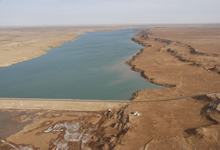 Water is the source of life. Its availability is an absolute necessity to meet human development goals. The role of water grows in importance in arid regions which are characterized with a low level of precipitations, scarce underground water supplies, poor vegetal cover and low natural diversity.
Water is the source of life. Its availability is an absolute necessity to meet human development goals. The role of water grows in importance in arid regions which are characterized with a low level of precipitations, scarce underground water supplies, poor vegetal cover and low natural diversity.
Hence, the results brought about by a political will to utilize water resources in the Saharan provinces have greatly contributed to change people’s lifestyle. This represented a huge challenge to the landscape as this process entailed draining water from sands in order to supply the population with water and to fertilize dry lands.
Before 1975, public water pipelines were inexistent; few categories of citizens had access to salty water supply networks and fresh waters carried from the Canary Islands.
The majority of the population were using the small quantities of rainwater “ghadir” that were stored in underground reservoirs called “matfiya”. The rare water drilling operations were undertaken at that time mainly to address the needs of phosphate mines in Bougraa.
In view of these challenges, Moroccan authorities focused on putting an end to this state of shortage that characterized this region through an enhanced productivity and a balanced distribution of consumption in urban and rural areas.
In order to overcome the enormous difficulties encountered in mobilizing water resources, an intensive programme for underground water drilling was prepared. Thanks to this programme, underground water strata were discovered, especially in layers of the cretaceous strata which become deeper as we head from the south to the north and from the east to the west; the depth ranges between 50 metres in Bir Anzaran and 1.100 in the area of Laâyoune.
Smara
Given the desert aspect of the region which is characterized with constant drought and high temperature, especially during summer, a steady supply of drinkable water has been the main preoccupation of the authorities. As early as 1978, explorative researches revealed very small quantities of water in the vicinity of the city such as Wad Al Gaez and Wad Sakia Alhamra. Attention was then directed towards exploring locations farther from the city which differ from the above-mentioned areas in terms of geology and topography. Thus, drinkable water had been supplied to the city via the underground waters of Sidi Ahmed Larousi from 1986 through 1993 with a flow amounting to 40 litres/second.
Since February 1994, Smara has been supplied with drinking water from Sidi Khattari after setting up a water treatment plant and an elevated reservoir of capacity 500 cubic metres, in addition to a pumping station. Moreover, the distribution network was restored and expanded to cover new quarters: it extends over 120 km whereas the monthly output amounts to 90.000 cubic metres.
The number of subscribers reached 6.996. However, with the urban expansion of the city and the demographic rise, this plant has been unable to address the growing needs of this vital substance particularly in summer where consumption reaches its highest rate and the deficit reaches 30. Consequently, the overall schedule of water distribution in Smara is greatly disrupted. Yet, the deficit rate will increase as the rural commune of Sidi Ahmed Larousi will be linked to the water network of Sidi Khattari.
To address this situation, the National Office of Drinking Water has scheduled a project for strengthening the production capacity of Sidi Khattari station. This will certainly contribute to enhancing its productivity and supplying the population of Smara with this vital substance on a regular basis.
As part of the promotion of rural areas, the State is deploying considerable efforts to supply the various population agglomerations with drinking water. Accordingly, Sidi Ahmed Larousi Centre has been supplied with this vital substance.
Laâyoune
Though it has limited resources, this city is well equipped with a network of drinking water. Since the year 1975, the National Office for Drinking Water has provided these regions with water equipments, through building and extending the channels necessary for the production and distribution of water.
The city of Laâyoune is supplied with water through a distribution network that covers 80% of the urban area. The capacity of production of drinking water reaches 12.600 m3 per day, of which 7000m3 is fresh water produced by the station of desalinisation; the remainder is provided by the water table called Fem Al Oued. The storage capacity of water is estimated at 16.660 m3.
Tarfaya
The city of Tarfaya is equipped with a station of water treatment through removal of minerals. The station produces every day an output of 100 m that is distributed through a public fountain. Another output of salty water estimated at 120 m per day is distributed through an individual network. The storage capacity reaches 250 m3.
Boujdour
In Boujdour, the capacity of clean water production is estimated at 800 m per day, produced through the desalination of sea water, and distributed through a network covering 80% of the regions of Boujdour. The storage capacity is in the order of 500 m.
Rural Communes
The rural communes of the region (Akhenfir, Addoura, Msid, Tinfad, Bougraâ, Dchira, Tah, Hekounia) are supplied with drinking water through tankers. Hence the necessity for the National Office of Drinking Water to implement a programme for providing these rural centres with drinking water as well as evaluating the existing resources.
Population growth and the increasing urban expansion will lead in the near future to a deficit in drinking water and to excessive use of water tables of the region. The future needs in terms of drinking water require the establishment of new stations for the desalinisation of sea water.